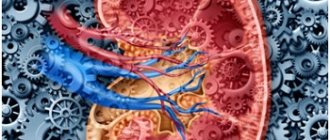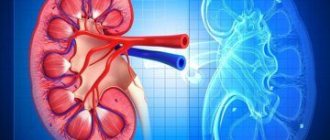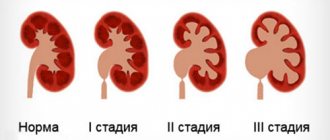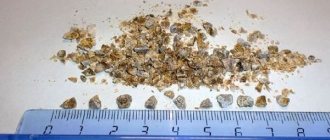Kidneys are paired organs that filter the blood from metabolic end products, as well as toxic substances that enter the body from the outside. During the filtration process, urine is formed, along with which these harmful substances are eliminated. In addition, the kidneys are part of the endocrine system, taking part in the synthesis of certain hormones. They are also involved in protein and carbohydrate metabolic metabolism.
Kidney failure is a disease in which these organs lose the ability to sufficiently perform their function.
Uremia occurs - poisoning of a person with toxic metabolic products, failure of the acid-base and water-salt balance, and as a result - disruption of the functioning of the entire body.
Kidney failure is a dangerous disease with a high risk of mortality. which requires immediate medical intervention and strict monitoring.
Kidney functions
excretory
The nephrons (the structural units of the kidneys) filter the blood, resulting in the formation of urine.
Excreted in urine:
- Protein metabolism residues: urea, creatinine, ammonium salts, sulfuric, phosphoric, uric acids.
- Excess water, salts, micro- and macro-elements, glucose.
- Hormones.
- Harmful substances of third-party origin, including medications.
Homeostatic
Homeostasis means the balance of the internal environment of the body. The amount and ratio of vital substances (for example, water, sodium, potassium, etc.) can fluctuate only within limited limits - even a slight imbalance leads to disease.
The kidneys “monitor” that the amount of substances excreted corresponds to the amount of substances received. This maintains water-salt, acid-base, electrolytic, and osmotic homeostasis. This means that a constant volume of blood, external and intracellular fluid is ensured, the uninterrupted flow of metabolic processes is ensured, and a normal level of blood pressure is maintained.
Endocrine
This is the synthesis of some biologically active substances and hormones.
For example, the kidneys produce the hormone erythropoietin, which stimulates the production of red blood cells in the bone marrow. They also complete the formation of active vitamin D3 (calcitriol), which forms bone tissue.
Metabolic
Participation in the breakdown of proteins and the construction of part of cell membranes. Synthesis of glucose from other substances.
What is kidney failure
If the kidneys cannot fully cope with their tasks, this condition is called renal failure.
The disease is divided into two forms - acute and chronic:
- Acute kidney failure or acute kidney injury (AKI) is a disease that develops over several days or weeks. It is potentially reversible - organ function is often restored. However, this does not always happen, and the patient develops chronic renal failure.
- Chronic renal failure (CRF) is a slowly progressive kidney pathology leading to irreversible impairment of their function. The disease develops from several months to several years.
AKI develops into chronic renal failure if the acute injury lasts more than 3 months and kidney function is not fully restored after the causes are eliminated. And also if the causes are permanent - for example, with autoimmune destruction of kidney cells.
If one kidney is damaged and the other is functioning normally, the healthy organ will take over the functions of both. The person will feel healthy both subjectively and according to laboratory indicators. Therefore, kidney failure occurs when both kidneys are affected.
Both acute and chronic decline in organ function can occur at any age, but occurs more often in older people.
Kidney failure: symptoms and treatment (Sergiev Posad)
The disease “renal failure”
is a serious condition that develops against the background of other diseases or lesions and is characterized by impaired renal function. Depending on the severity and duration of the course, acute and chronic forms of renal failure are distinguished. The pathology can affect people of any age and gender, but more often young women suffer from impaired renal function.
In most cases, the cause of kidney failure is a disorder in the organ itself, caused by external or internal environmental factors. However, diseases that are absolutely not related to the kidneys can also provoke pathology. The most common reasons include:
- Congenital pathologies of the kidney structure;
- Chronic diseases in the body - diabetes mellitus, autoimmune diseases, liver cirrhosis or liver failure, urolithiasis;
- Inflammatory kidney diseases that were not fully treated or occurred with complications;
- Malignant neoplasms in renal tissue;
- Blockage of the ureters with stones, resulting in retention and accumulation of urine in the kidneys, overstretching of the organ and the formation of pathology;
- Chronic glomerulonephritis;
- Intoxication of the body;
- Massive blood loss or reduction in circulating blood volume, for example, with burns;
- Poisoning by chemicals and poisons;
- Self-medication with nephrotoxic drugs, long-term use of antibiotics or other drugs, without a doctor’s prescription.
In some cases, kidney failure in women can develop during pregnancy.
Signs of kidney failure
Signs of kidney failure in women largely depend on the degree of dysfunction of the organ:
- Initial degree - at this stage there are no clinical symptoms, however, pathological changes are already occurring in the tissues of the organ;
- Oliguric stage - symptoms appear and increase: the amount of urine excreted per day decreases, lethargy, lethargy, nausea, vomiting, increased heart rate, shortness of breath, cardiac arrhythmia, abdominal pain appear (the duration of this stage is up to 10 days);
- Polyuric stage - the patient’s condition returns to normal, the daily volume of urine increases and often corresponds to physiological indicators, however, at this stage the development of infectious and inflammatory diseases of the urinary system is possible;
- Rehabilitation stage - the kidneys begin to function fully and are almost completely restored. If a large number of nephrons are damaged during acute renal failure, then complete restoration of organ function is impossible.
Symptoms of kidney failure
The chronic form of the disease develops as a result of the progression of acute renal failure. The condition is characterized by the destruction and death of the kidneys (glomeruli, nephrons, parenchyma), as a result the organ cannot perform its functions - this leads to disruptions in the functioning of other vital organs.
Depending on the degree of damage to the renal tissue and the severity of the patient’s condition, several stages of chronic renal failure with different symptoms are distinguished:
- Hidden stage (latent) - there are no clinical manifestations of the disease, so the patient has no idea about his condition - however, with increasing physical activity, weakness, dry mouth, drowsiness, lethargy, fatigue, and increased urine output occur;
- Clinical stage - at this stage, clinical symptoms of intoxication of the body occur: nausea, vomiting, pale skin, lethargy, drowsiness, lethargy, a sharp decrease in the volume of urine excreted, diarrhea, the appearance of bad breath, tachycardia, cardiac arrhythmia, headaches;
- Stage of decompensation - in addition to the signs of general intoxication of the body, complications are added in the form of frequent respiratory diseases, inflammatory infections of the urinary organs;
- Compensation stage (or terminal stage) - there is a decline in the functions of vital human organs, resulting in death. Clinically, this stage is manifested by symptoms of severe intoxication of the body, impaired functioning of all organs, bad breath, jaundice of the skin, and the development of neurological disorders.
At the first appearance of such signs, you should immediately consult a urologist.
The sooner renal failure is identified and treated, the higher the patient’s chances of a complete recovery.
The acute form of the disease is a reversible condition, for the treatment of which it is important to determine the causes of organ dysfunction.
If kidney failure is not treated, the patient will quickly die.
Join us in social networks!
Dear friends! We invite you to join our official communities on social networks!
- VKontakte: https://vk.com/centrparasels
- Classmates: https://ok.ru/parasels
- Facebook: https://www.facebook.com/parasels.ru
How does kidney failure manifest?
Symptoms depend on the form and stage of development of the disease:
- With AKI, the first symptoms are a sharp decrease or cessation of urination.
- With CPP, the progression of symptoms occurs slowly. At an early stage, a consequence of kidney dysfunction may be the kidneys' inability to reduce the volume of urine at night by reabsorbing water from it. Therefore, with a mild form of the disease, the only symptom may be nocturia - frequent urination at night.
As the pathology progresses, the filtering and excretory function of the kidneys is impaired. Metabolic acids are not removed from the body, so the acid-base balance of the blood shifts to the acidic side (acidosis). Urea, phosphorus, nitrogenous substances accumulate in the blood, and an excess of salts occurs. This self-poisoning of the body is called uremia, or urine leakage.
How renal failure manifests itself in uremia can be understood by the presence of the following symptoms:
- decreased appetite;
- apathy, general weakness;
- thirst;
- unpleasant taste in the mouth;
- sleep disorder;
- memory impairment;
- decrease in body temperature to an average of 35C;
- nausea.
If treatment is unsuccessful and the disease develops further, intoxication spreads to the nervous system. A person experiences involuntary muscle twitching and inhibition of reactions.
The body begins to rid itself of toxins in other ways, such as through continuous vomiting and diarrhea. The smell of ammonia appears from the mouth.
Nitrogenous substances are released through the skin and mucous membranes, which leads to their irritation, and then to uremic gastritis, tracheitis, and stomatitis. Severe pathology may occur - inflammation of the heart muscle (pericarditis).
When the lungs fill with fluid and the pericardium is damaged, shortness of breath occurs.
In the terminal stages of uremia, whitish urea crystals (uremic frost) appear on the patient’s nose, chin and neck. Blood pressure drops and confusion occurs.
Death may occur from uremic coma.
In severe stages of renal failure, the functioning of almost all body systems occurs.
In this case, the kidneys cannot produce the hormone erythropoietin in sufficient quantities, so the patient’s red blood cell count drops and anemia develops.
Calcitriol production is also reduced, leading to bone fragility. In children, kidney failure leads to delayed bone growth.
Hypertension and heart failure develop.
A persistent increase in uric acid levels often leads to gout.
Clinical picture
The symptoms of kidney failure depend on the current phase and stage of the disease. ARF is characterized and manifested by:
- At the initial stage, there are signs of the underlying disease. Primary changes in renal tissue are observed.
- With oliguric, organ dysfunction increases, the amount of urine decreases (up to 400 ml). Metabolic products accumulate in the body and the water-salt balance is disturbed. The pathology is manifested by weakness, lethargy, loss of appetite, attacks of vomiting and nausea, convulsive muscle contractions, increased heart rate, arrhythmic abnormalities, and shortness of breath. In some cases, abdominal pain, gastrointestinal ulcers and bleeding are present. The stage lasts 5-11 days and is considered the most difficult.
- With polyuric, there is a normalization of the general condition, an increase in the volume of urine exceeding the norm. Infectious processes develop in parallel, and symptoms of dehydration are present.
- With recovery, kidney functionality is normalized, the process continues for up to one year. If most of the organ tissue is damaged, complete regeneration is impossible.
Signs of the development of chronic renal failure are not recorded at the initial stages. Symptoms occur with dysfunction of 80% of the organ tissue, the first manifestations are expressed:
- increased fatigue, general weakness;
- lethargy, impaired urine output with an increased volume of up to 4 liters per day;
- frequent night urination in the first stages and its sharp decrease in the last;
- nausea, vomiting, convulsions;
- dryness of the oral mucosa and a feeling of bitterness;
- obsessive itching, discomfort in the abdominal area;
- bleeding in the stomach, from the nose - due to a slowdown in the rate of blood clotting;
- dyspeptic disorders with diarrhea;
- skin hemorrhages, infections due to dysfunction of the immune system.
Late stages lead to shortness of breath, short-term loss of consciousness, attacks of bronchial asthma, and coma. In chronic renal failure, symptoms increase more slowly than in the acute course of the disease.
Causes of kidney failure
Kidney failure develops for three main reasons:
- circulatory disorders of organs;
- nephron damage;
- blockage of the urinary tract.
Two pathologies most often lead to the development of chronic renal failure:
- Diabetes.
- Severe hypertension (high blood pressure).
It is these diseases that lead to damage to the small vessels that feed the kidneys and persistent disruption of their blood circulation.
In some cases, it is impossible to identify the cause of the disease.
1.General information
The collective term “toxic nephropathy” is used to define a wide group of renal lesions caused by poisoning with chemical or organic substances. Most of these substances have a pronounced nephrotoxic effect and, in certain concentrations, can cause severe or life-threatening disorders of the filtering and homeostatic functions of the kidneys (homeostasis is the constancy of internal conditions in the body), that is, acute renal failure. In addition to the specific toxicogenic failure itself, which is most often accompanied by liver damage in the structure of a single hepatorenal syndrome, nonspecific toxiconephropathy is also considered separately as a reaction of the kidneys to harmful biochemical, hemodynamic or mechanical factors.
In general, toxic nephropathy is a condition with a high mortality rate, the frequency of which, however, varies widely (20-70%), since it depends on the composition of the nephrotoxic poison, its concentration, speed of care, the presence of concomitant diseases and lesions, age and many other factors.
A must read! Help with treatment and hospitalization!
Diagnostics
The doctor performs a visual examination of the patient and prescribes laboratory and instrumental tests.
Blood chemistry:
- Determination of the level of metabolic end products in the blood: creatinine, uric acid and nitrogen.
- Establishing the level of blood acidity (detection of acidosis).
- Determination of the amount of electrolytes in the blood.
General blood analysis:
Determination of hemoglobin and red blood cell levels. Indicators below normal may indicate a loss of the kidneys’ ability to participate in the synthesis of red blood cells.
Urine tests:
- A general clinical analysis allows you to determine the presence of protein, blood, and pathological cells in the urine.
- Biochemical - reveals the amount of electrolytes - sodium, potassium, calcium, phosphate compounds.
Of the hardware studies, ultrasound and CT (computed tomography) are most often prescribed.
In severe cases, a kidney biopsy is used - a tissue analysis that allows one to judge the extent and nature of its damage. It is not prescribed if the ultrasound revealed a significant reduction in organs and scar changes.
3. Symptoms and diagnosis
In the clinical picture of toxic nephropathy, there are three main degrees of severity. The lung is characterized mainly by changes in the biochemical composition of urine; with an average degree, structural changes in urine and blood reach a significant and unsafe degree, and symptoms include certain urination disorders; finally, the severe degree implies acute renal failure itself, or acute renal failure, which, in turn, is divided into several phases.
Thus, after the initial general toxic phase (up to 3 days), oligo- or anuria occurs (respectively, a sharp reduction or complete cessation of urine output), which is characterized by gross disturbances in water and electrolyte balance, acidosis (pH shift to the acidic side), systemic swelling, including pulmonary and cerebral edema, depression of cardiac, hematopoietic, metabolic and central activity, vascular irritation and inflammation with possible hemorrhages (internal bleeding). Considering the severity of these possible manifestations of acute renal failure, this phase is not always reversible and in some cases is fatal.
With a favorable course, diuresis normalizes and then exceeds normal volumes (polyuric phase), which is also quite dangerous - due to possible dehydration (dehydration of the body). This phase can last up to one month.
Final recovery and normalization of renal function is a much longer process that can take several years and still result in residual renal dysfunction.
In the diagnosis of toxic nephropathies, two factors are vital: information about the etiology of poisoning (which substance or substances affected the kidneys) and the time that elapsed from the moment of intoxication to the start of medical care. In addition, the degree of concomitant or underlying liver damage is of great importance. In general, the diagnosis is established clinically, confirmed laboratory and requires constant monitoring of many biochemical, cardiac and other indicators. Of the instrumental diagnostic methods, the most informative in this case are ultrasound and CT (including in angiographic mode), contrast X-ray studies (urography, pyelography), urine culture; According to indications, cystoscopy is performed, and a biopsy sample is taken for histological analysis.
About our clinic Chistye Prudy metro station Medintercom page!
Treatment of kidney failure
The chronic form of the disease usually progresses even with treatment. However, the speed of the process can be reduced and the patient’s quality of life improved.
This depends on controlling the disease that led to the development of chronic renal failure. For example, in case of diabetes mellitus, it is very important to maintain normal sugar levels, as well as blood pressure levels in case of hypertension - otherwise the quality of kidney function will rapidly decline.
Measures taken to preserve kidney function are extremely important:
- Limit fluid intake.
- Refusal to take a number of medications that place increased stress on the kidneys.
- Diet therapy. Restriction in the diet of foods and drinks high in sodium, phosphorus, and potassium. This includes table salt, dairy products, liver, legumes, nuts, and the amount of protein is also strictly dosed. In the case of acute renal failure, the diet must be followed until the patient recovers, in case of chronic renal failure - throughout life.
- Drug therapy. Prescribed by a doctor based on test results.
- Dialysis. Hardware removal of waste products. It is performed for severe and predictably long-term renal dysfunction. For severe chronic renal failure, it is used on an ongoing basis.
The patient must constantly monitor blood biochemistry - the level of creatinine, urea and phosphates in the blood, its acidity, and also undergo regular urine tests.
In case of complications - anemia, heart failure, osteodystrophy, etc. – it is necessary to involve targeted therapy.
If severe chronic renal failure develops, a person is advised to undergo a kidney transplant.
Without adequate treatment, kidney failure is fatal.
Sources of disease development
The prerequisites for the formation of renal failure depend on the phase of the pathological process. AKI is provoked by various factors, according to the classification:
- With preneral - the deviation is associated with impaired blood circulation in the kidneys. The organ experiences a deficiency of nutrients due to a decrease in blood flow speed. The result of the changes is a disruption in the processes of urine formation and pathological changes in the tissues of the organ. The disease is registered in 55% of cases.
- In renal – occurs with pathological kidney tissue. When the organ is ill, there are no circulatory problems, but the organ is not able to produce urine normally. The disease is recorded in 40% of patients.
- In postrenal, there is a normative formation of urine with its retention against the background of obstruction of the urethra. When one ureter is blocked, a healthy organ replaces the diseased one and PN does not occur. The condition occurs in 5% of cases.
Sources of chronic renal failure are presented:
- congenital, genetic kidney abnormalities;
- development of the disease against the background of other chronic pathologies;
- pathological processes in the urinary tract, provoking a narrowing of the urethral canal: with tumors, urolithiasis, etc.;
- chronic course of pyelonephritis, glomerulonephritis.
The pathological condition occurs against the background of uncontrolled use or overdose of medications.










